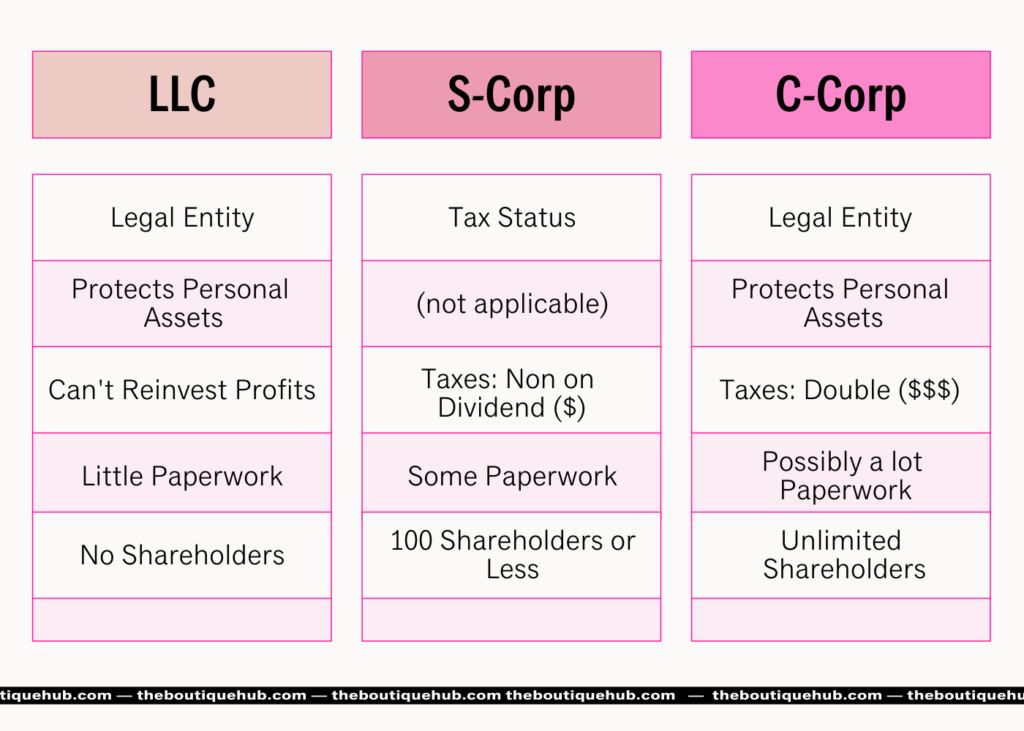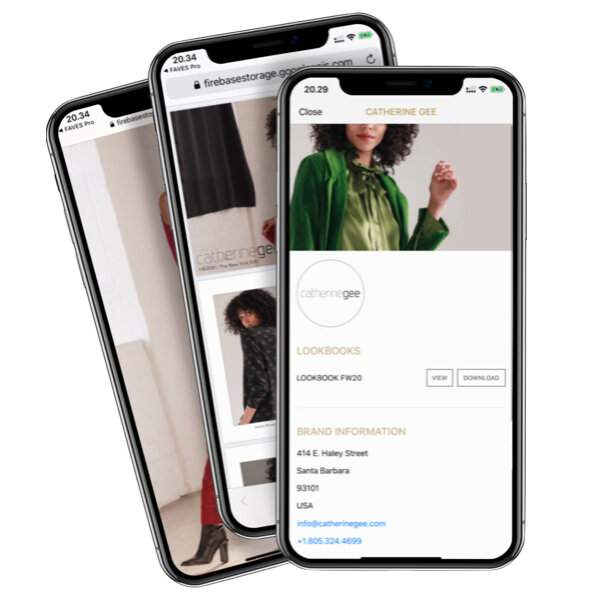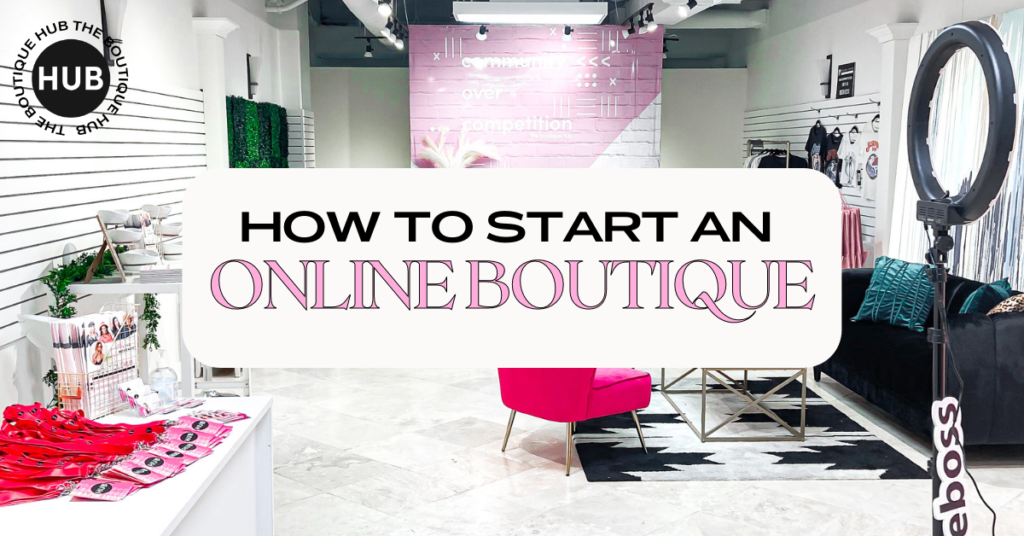There’s nothing more exciting than fulfilling your dreams by starting your own online boutique. But getting started can seem like an overwhelming task. You may be asking yourself, where do you even start? No need to worry, we are here to help! Here are some tips and tricks for how to start an online boutique.
There’s no better time than now to learn how to start an online boutique. The best thing to do? Start. Follow these seven steps and just do it. You got this Boutique Boss!
Looking for a more in-depth guide to starting a boutique? Use our FREE downloadable guide with 20 Steps to Starting a Boutique.
7 Steps to Start an Online Boutique
Step 1: Research!
Before choosing a boutique name and logo, research your target audience.
Define Your Target Customer
Who are they, what do they value, what do they do in their free time? These are all great questions to ask yourself during this process. Some other things to consider during this initial research process are your online presence and competition.
-Where are your target customers’ eyeballs?
-What websites are they looking at?
-Where else do they shop?
-What social channels are they on?
-What are their shopping struggles?
- Finding the right sizes?
- Are they too busy to search for looks, lines, or functions?
- Are they price-driven or quality-driven?
Finding a product 1st and a customer 2nd is a risky way to build a business! If you find a customer in need of a solution, and then you offer the solution – there you will find a sustainable business! This is an interesting way to think about marketing and a way to get a better insight into your customer.
Who Are Your Competitors?
Who are the other players in this game? What are their strengths and weaknesses? Identify these, and you will find opportunities!
Step 2: Name, Logo and Domains
After brainstorming and coming up with the perfect name, snag those social handles. You want to make sure your boutique will be easily found online by your customers. Nothing’s worse than finding a business you love but not being able to find them on socials because of different spelling in their handles … make sure to avoid this issue.
Business social handles should be:
- Short
- Memorable
- Consistent
- Distinguishable
- Easy to spell
- Informative
Be sure to also purchase a domain for your website. There are many websites that you can purchase a domain name from such as GoDaddy, IONOS by 1&1, BlueHost, or even straight through Shopify. Each platform may offer different monthly pricing based on availability, so check out different options to see what will be your best bet. Top-level domains or TDL’s are the domain extensions. The most popular ones include .com, .net, .edu, .org and .gov. In a boutique’s case, .com is usually the best way to go as it is the most memorable for customers. A domain’s cost can range from $2 – $50 a year depending on popularity.
TIP: If the domain that you want is already taken, you have the option of contacting the domain owner and negotiating a fair price.
Once you purchase your domain, you will be prompted to complete its registration and verify ownership. These instructions and specific how-tos will be outlined on the platform you choose to purchase the domain from. Additionally, when it’s time to start building that website, freelance designers can be found on websites such as Fiverr or Upwork and can be hired based on your request and your budget. As we always say here at the Hub, do what you do best and hire out the rest!
Step 3: Legal and Organizational Matters
Protecting yourself, your assets and your ideas is a very important part of being a business owner. The bigger you get the bigger your problems, but also the more you have to protect. That is why it is so important to start off protecting yourself.
1. Determine your Business Entity type – the entity you choose will determine implications for your business both legally and financially. Getting a small business loan and the amount of taxes you will pay depends on your entity type.

2. Licenses – The licenses and permits you need from the state, county, or city will depend on your business activities. You can’t legally perform business without the proper licenses.
3. EIN Number – also known as an Employer Identification Number or Tax ID Number, is used to identify a business entity, trust, estate, and various other entity types.
4. Sales Tax Permit – necessary for selling online or in-store. This permit allows the seller to collect sales tax. Remember, this tax is not yours! Sales tax is paid to the state quarterly and submitted along with the appropriate state tax forms.
5. Trademark – To keep others from profiting from your work. Trademark your name, logo, and slogan. Do your homework prior to registering your trademark to ensure what is yours is yours and not someone else’s. This protects your business from copycats but also protects you from lawsuits in the future. You can search the USPTO Trademark DataBase here to make sure you are not infringing on someone’s trademark.
Create a unique logo using Canva – simple enough anyone can do it.
6. Copyright – Protect your work. This shows proof of ownership and the ability to allow others to use it or not use it. You can Copyright tangible creative work, photos, art, music, etc.
7. Bookkeeping – Keeping up with money coming in and money going out of your business on a weekly basis is important to success. Proper documentation and transaction organization provides clarity in your business. Paying taxes and producing financial documents becomes far easier with a bookkeeping system in place.
The Boutique Hub is not a law firm, nor are we attorneys. The information provided is general legal information and should be taken into consideration when starting a business. If you are unsure of legal matters you should contact a lawyer.
Step 3: Branding and Surprise… More Research!
Now that you have your initial research from step one, your name and logo, and your legal matters out of the way, it’s time to connect the dots and figure out branding elements and create the perception you hope consumers have as they meet you, see your store, and experience your company, product or service.
There are three phases of branding:
- Brand Identity – how your brand looks – It is the way that your business becomes recognizable. Everyone recognizes Coca Cola, Nike, and Apple.
- Brand Strategy – describes your mission! This solidifies your purpose, promises and how you can solve your customers’ problems. How do you want the world to see you?
- Brand Marketing – Remember your customer persona, if you target everyone you attract no one. Brand marketing is basically communication of a brand to customers.
Put it all together! Create a company mood board to put all of your efforts into focus, find clarity through your mood board. Include things such as branding elements, graphic design elements, and product types to confirm your brand identity!
Branded packaging can be found on Vista Print.
Step 4: Set Up Your Shopify Account
Making sure you have the right tools to sell online is critical. Shopify is the most robust of all e-commerce platforms for online boutique owners, and very simple to get started with. Start a free trial here with Shopify.
Get it right the first time with this Shopify Launch Checklist.
Multi-channel retailing is a necessity for most online stores. Here is a list of Sales channels that are compatible with your Shopify site. Reach more customers by coming to them instead of waiting for them to find you!
Knowing what you are selling, to whom, at what price, and when it is sold is important for sales forecasting, event planning, and budgeting. In order to have the best data possible, it is important that you enter the following information every time you upload product information. (Hup tip – use the FAVES app to make this simple and efficient). Make sure you’re filling out all of the essential product details as you add products including:
- Vendor
- Product type/classification (example Denim Jeans instead of Bottoms)
- Cost – Retail prices
- Detailed descriptions (color, style, cut, fabric, etc)
- Date of Order
- Quantity ordered
- Size variants
- Cancel Date – a date that you expect items to be in your possession

Are you a LIVE seller: Check out CommentSold – they are one of our preferred partners who offer a generous Hub member discount for their services. Link CommentSold and Shopify together to have an all-in-one-stop platform.
You can never be too organized when running a business! Remember – knowledge is power, the more you know about your business the better you can run it! Shopify has endless apps and integrations, and if you go on to add a brick and mortar you can use their POS or integrate into many others with even more reporting!
Check out the Boutique Boss Planner as the #1 Retailer Resource on the market. Organize your sales, customers, expenses, inventory, promotions, and more right here!
Step 5: Wholesale Shopping
Love to shop? You’ll definitely start having fun with this part! There are lots of online wholesale marketplaces such as Hubventory, but we suggest attending wholesale apparel markets as a way to find and connect with vendors, especially for newbies.
At markets, you’ll be able to see the quality of the apparel, get inspiration, build relationships with vendors, meet and network with other boutique owners, and also visit the Hub’s showroom for education, support, and swag! Your products are the biggest impression people will correlate with your business, make sure it’s a good one. Here are a few tips to keep in mind when buying wholesale:
1. Know your customers
2. Understand all your wholesale buying options (markets, platforms, etc)
3. Ask about product sizing
4. What types of pre-packs does the vendor offer
5. What are the minimum requirements of the vendor
6. Price for profit
Hub members know that when you are wholesale shopping there are a few questions to ask yourself:
- Yes, this is cute but who will buy this? Can I name off a few customers (refer back to your target customer profiles from step one) that I know will buy this?
- What will your customer pay for this item? Ask yourself this before looking at the price tag. If you look at the price tag first you will automatically cap your pricing limits. We recommend that you look at the possibilities with pricing instead of limiting yourself. Example: If you look at a garment and feel that your customer would purchase the item for $50 and find out the cost of the item is only $15… great! If you looked at the wholesale price first, odds are you would limit your retail pricing to reflect the cost of the item.
- What are the shipping dates on this? If my launch date is next month, will this arrive in time?
Step 6: Final Business Tools
Before you get the ball officially rolling, you’ll want to make sure you have everything checked off your lists such as having a good shipping provider and supplies, a marketing program, and other tools such as racks for storage, a label printer, mailer cards, etc.
- Computers and Printers
- Photography Equipment
- Mannequins
- Steamer
- Shelving
- Tagging Equipment
- Packaging
- Labels
- Polymailers
- Hangers
Communication is KEY! Check out Email or SMS marketing services such as Glow Group Kalvio, Postscript, Slicktext, or Sentext to set up your email flows. Here is a Sample Email Automation Series:
- Welcome Email
- Electronic sales receipts
- Abandoned cart notifications
- Order confirmation with expectations and Thank you.
- Shipping notifications
This series of emails will reduce confusion with your customer and increase customer loyalty which means great CLV (customer lifetime value).
Step 7: Build the Hype!
Now that you finally have everything set in place to officially launch your business, it’s time to build some hype. Remember those social handles you secured in step 2? Let’s revisit those. And that mood board you’ve been beautifully articulating? Content time! Start curating your feed, encourage friends and family to follow your boutique’s page, and start building some excitement around your launch date. Some ways to do this is to show some sneak peeks or a snapshot of a mood board. This is also where you can start to collect some data from family and friends. Post a question box on your Instagram story and collect emails for your email marketing platform to send them a launch day email!
Since we are on the topic of content marketing, here is a Hub tip: never, and we mean never use stock photos. Your customers are buying from you for a reason. Taking the time to take your own quality photos (yes, your iPhone will most definitely work) will have a huge payoff and will show value to customers.
For more marketing tips to attract, retain, excite and educate your customer check out our Small Business Marketing Handbook.
Step 7: Pre-Launch Day and Launch Day!
Recruit some friends or customers to run through your site and literally try to break it before you launch it! Test everything, and test it again! Imagine creating a brick-and-mortar store, merchandising it, stocking it, staffing it, and marketing it only to launch it on opening day but forgetting to bring the keys to unlock the door?
Test your payment platforms, taxes, email automation, load speed, inventory counts, pop-ups, and more! Take feedback in stride and remember the reason you started this business in the first place! Stay true to your mission and have fun!
It’s time to celebrate, learn from your mistakes, pivot, and adjust! This is a marathon, not a sprint! Remember to stay active on socials all day and communicate with a mix of education, humor, encouragement, sales strategy, and questions to keep your customers coming back for more!
This is just the beginning, Boutique Boss!
Next Steps …
- All experienced Boutique Bosses know that education never ends… Our Boutique Owner Basics course was curated for beginning boutique owners just like you, and is here to answer any questions you might have! We know what it’s like to start, run, grow and scale your boutique business, and work with thousands of boutique owners every single day inside of The Boutique Hub.
2. If you’d love more resources to help you on your business venture, join us inside, listen to our Boutique Chat Podcast, tune in to our Youtube videos, our educational blog posts, or any of our socials!
3. Once you’re open join the Boutique Hub, and join the waitlist to shop on Hubventory!

